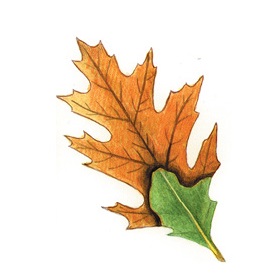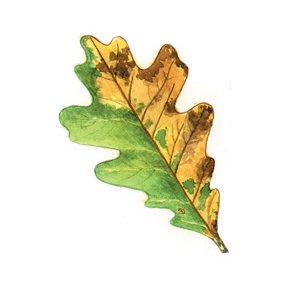Foresters, arborists or pathologists experienced with oak wilt can often diagnose the disease in the field using host species, symptoms and mortality patterns. Properly sampling suspect trees and culturing the samples in a qualified laboratory may be needed in some cases.
Watch this short video from Iowa State University on how to prepare a sample for their diagnosis lab.
 Initial symptom is a subtle off-green color shift that may be visible in the upper portion of the tree. This my first appear in mid-to late spring or throughout the summer. The leaves begin to wilt quickly from the top of the crown downward and have a bronzed look. Oak wilt is usually identified in red oaks by rapid leaf discoloration and wilting. The outer ring of vessels of diseased trees will be plugged with a brown substance that is often visible in cross sections taken in the spring after the year that a red oak completely wilted.
Initial symptom is a subtle off-green color shift that may be visible in the upper portion of the tree. This my first appear in mid-to late spring or throughout the summer. The leaves begin to wilt quickly from the top of the crown downward and have a bronzed look. Oak wilt is usually identified in red oaks by rapid leaf discoloration and wilting. The outer ring of vessels of diseased trees will be plugged with a brown substance that is often visible in cross sections taken in the spring after the year that a red oak completely wilted.
 White oaks usually die slowly, one branch at a time, over one-to-many years. Leaf wilting and death happen in a similar way to that of red oaks, but these symptoms usually progress much more slowly in white oaks. Affected leaves show a pattern of discoloration somewhat similar to that of red oaks, but the pattern is more variable. Leaves develop yellow veins that eventually turn brown. Discoloration on leaves proceed from the margins to the base. Affected leaves fall from scattered, affected branches within the tree crown. The crown progressively (over multiple years) thins out until the entire tree is dead.
White oaks usually die slowly, one branch at a time, over one-to-many years. Leaf wilting and death happen in a similar way to that of red oaks, but these symptoms usually progress much more slowly in white oaks. Affected leaves show a pattern of discoloration somewhat similar to that of red oaks, but the pattern is more variable. Leaves develop yellow veins that eventually turn brown. Discoloration on leaves proceed from the margins to the base. Affected leaves fall from scattered, affected branches within the tree crown. The crown progressively (over multiple years) thins out until the entire tree is dead.